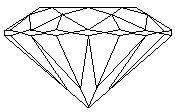





How to Buy a Diamond


How to Select the Perfect Diamond
There are few substances in nature, if any, more precious, weight for weight, than a diamond. And none are more lasting. But a diamond does not start as a gem of marvelous beauty. It takes many steps and the skills of many craftsman to bring you the diamond that sparkles in your fine jewelry.
All diamonds are rare, but some are rarer than others. Just like fine wines, watches, horses, cars... all diamonds have qualities and characteristics that make them different from each other and more, or less, valuable. No two diamonds are the same!
We at Earth Stones feel that it is important for you to understand these differences. There are four main characteristics of a diamond that we consider (The four C's) as well as shape and some other considerations:
Carat
While Karat (with a K) pertains to the pure gold content of the mounting of your ring, CARAT (with a C) refers to the size of your diamond and is the measure of its weight. A carat is divided into 100 "points".
| CARAT | 1/5 | 1/4 | 1/3 | 1/2 | 3/4 | 1CT | 2CTS |
| POINTS | 20 | 25 | 33 | 50 | 75 | 100 | 200 |
But size and weight alone do not determine the value of a diamond. For instance, it is very possible for a smaller diamond to be worth more than a larger one. The other three C's must be considered in arriving at the cost of a diamond.
Cut
The "Brilliance" in a diamond is one of its most admired qualities. The more fire it has, the more life it has.
This does not happen accidentally. It takes a master craftsman cutting the 58 Facets along established ideal proportions to obtain a perfectly finished diamond. A small change in the angle of the 58 Facets will reduce the brilliance dramatically.

"Life" and "Brilliance" are created by light rays bouncing and reflecting in and out of the facets of a diamond. The angles of reflection are all important, as shown below.

The Proper Cut reflects light out through the table providing the "Life and "Brilliance" of a diamond. Whereas, a "Too Shallow" cut transmits light through the bottom and a "Too Deep" cut reflects light out the sides.
Color
Diamonds are found in nature in all colors of the rainbow, and some are very rare. For instance, the magnificent 44.5 Carat "Hope" diamond, is a sapphire blue.
GIA Color Grade Scale
| Colorless | Near Colorless | Faint Yellow | Very Light Yellow | Light Yellow |
| D E F | G H I | J K L M | N O P Q R | S T U V W X |
Any variance from white, or colorless, not only affects the price, but the beauty of a diamond as well.
Clarity
"Clarity" describes the various internal flaws in a diamond. These flaws are the "Fingerprints" of a diamond and no two are alike.

A flawless diamond, where no internal inclusions can be seen by a trained expert using a 10-power loupe, is extremely rare and very expensive.
The number and the type of flaws, and whether or not they are visible to the unaided eye, are factors in determining the price you pay for your diamond.
Comparative Clarity Grading Systems
| F-VVS | VVS | VS1 | VS2 | SI1 | SI2 | I1 | I2 | I3 |
Keep in mind that minor flaws, invisible to the unaided eye, do not detract from the beauty of a diamond but do affect the price.
Shape
If your preference is other than the "Brilliant" cut (e.g., round) diamond, Earth Stones can supply the shape to suit your fancy.
Our selection includes exceptionally well proportioned "Fancy" cuts such as the Marquise, Oval, and Pear, as well as the more exotic cuts such as the Emerald cut and the Heart shaped diamond.

Other considerations
Other important information to remember in selecting your diamond ring or fine jewelry.
- Diamond prices are set by the world demand on these gems. In most cases, bargain prices result in only lower grades being presented as finer goods. Don't be fooled!
- Workmanship is another concern when selecting your fine jewelry. Look at your selection carefully. If the setting job is poor, you'll be able to tell. At Earth Stones, we take pride and show special attention as to how your diamonds are set.
- Diamond prices change with each change of the four C's. As stated prior, no two diamonds are the same. Be careful in trying to compare. When you compare diamonds, be sure to compare diamonds of similar characteristics. In most cases, cheaper is not better.
Earth Stones is your diamond source because of our commitment to quality and service. We have been providing our area with fine jewelry for many years. We are proud to be your jeweler. Please feel free to contact us at any time to discuss any concerns.
Thank you for considering us for your jewelry needs!


This site Validates under the following guidelines:


